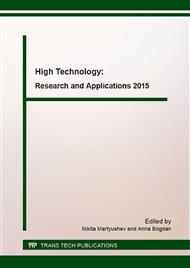[1]
J. -F. Zou, Z. -Z. Yu, Y. -X. Pan, X. -P. Fang, Y. -C. Ou, Conductive mechanism of polymer/graphite conducting composites with low percolation threshold, J. Polym. Sci.: B: Polym. Phys. 40 (2002) 954–963.
DOI: 10.1002/polb.10141
Google Scholar
[2]
Y. Xi, A. Yamanaka, Y. Bin, M. Matsuo, Electrical properties of segregated ultrahigh molecular weight polyethylene/multiwalled carbon nanotube composites, J. Appl. Polym. Sci. 105 (2007) 2868–2876.
DOI: 10.1002/app.26282
Google Scholar
[3]
J. Bouchet, C. Carrot, J. Guillet, G. Boiteux, G. Seytre, M. Pineri, Conductive composites of UHMWPE and ceramics based on the segregated network concept, Polym. Eng. Sci. 40 (2000) 36–45.
DOI: 10.1002/pen.11137
Google Scholar
[4]
J. Sandler, M.S.P. Shaffer, T. Prasse, W. Bauhofer, K. Schulte, A.H. Windle, Development of a dispersion process for carbon nanotubes in an epoxy matrix and the resulting electrical properties, Polymer 40 (1999) 5967–5971.
DOI: 10.1016/s0032-3861(99)00166-4
Google Scholar
[5]
R.P. Kusy, Influence of particle size ratio on the continuity of aggregates, J. Appl. Phys. 48 (1977) 5301–5305.
DOI: 10.1063/1.323560
Google Scholar
[6]
A. Malliaris and D.T. Turner, Influence of particles size on the electrical resistivity of compacted mixtures of polymeric and metallic powders, J. Appl. Phys. 42 (1971) 614–618.
DOI: 10.1063/1.1660071
Google Scholar
[7]
J. Feng, C. -M. Chan, Carbon black filled immiscible blends of poly(vinylidene fluoride) and high density polyethylene: Electrical properties and morphology, Polym. Eng. Sci. 38 (1998) 1649–1657.
DOI: 10.1002/pen.10335
Google Scholar
[8]
O. Breuer, R. Tchoudakov, M. Markis, A. Siegmann, Electrical properties of structured HIPS/gamma-irradiated UHMWPE/CB blends, Polym. Eng. Sci. 40 (2000) 1015–1024.
DOI: 10.1002/pen.11229
Google Scholar
[9]
G. Geuskens, J.L. Gielens, D. Geshef and R. Deltour, The electrical conductivity of polymer blends filled with carbon black, European Polym. J. 23 (1987) 993–995.
DOI: 10.1016/0014-3057(87)90047-4
Google Scholar
[10]
F. Gubbels, S. Blacher, E. Vanlathem, R. Jerome, R. Deltour, F. Brouers, P. Teyssie, Design of electrical composites: determining the role of the morphology on the electrical properties of carbon black filled polymer blends, Macromolecules 28 (1995).
DOI: 10.1021/ma00109a030
Google Scholar
[11]
J.F. Feller, S. Bruzaud, Y. Grohens, Influence of clay nanofiller on electrical and rheological properties of conductive polymer composite, Materials Letters 58 (2004) 739-745.
DOI: 10.1016/j.matlet.2003.07.010
Google Scholar
[12]
L. Liu, J.C. Grunlan, Clay assisted dispersion of carbon nanotubes in conductive epoxy nanocomposites, Adv. Funct. Mater. 17 (2007) 2343–2348.
DOI: 10.1002/adfm.200600785
Google Scholar
[13]
S.M. Miriyala, Y.S. Kim, L. Liu, J.C. Grunlan, Segregated network of carbon black in poly(vinyl acetate) latex: Influence of clay on the electrical and mechanical behavior, Marcomol. Chem. Phys. 209 (2008) 2399–2409.
DOI: 10.1002/macp.200800384
Google Scholar
[14]
T.J. Moon, J.H. Kim and C.H. Choi, Physical properties and adhesion of the polymer/metal composites, Polymer (Korea) 7 (1983) 380–391.
Google Scholar
[15]
K. Levon, A. Margolina and A.Z. Patashinsky, Multiple percolation in conducting polymer blends, Macromolecules 26 (1993) 4061–4063.
DOI: 10.1021/ma00067a054
Google Scholar
[16]
J.G. Mallette, A. Marquez, O. Manero, R. Castro-Rodriguez, Carbon black filled PET/PMMA blends: Electrical and morphological studies, Polym. Eng. Sci. 40 (2000) 2273–2278.
DOI: 10.1002/pen.11359
Google Scholar
[17]
C. Calberg, S. Blacher, F. Gubbels, F. Brouers, R. Deltour, R. Jerome, Electrical and dielectric properties of carbon black filled co-continuous two-phase polymer blends, J. Phys. D: Appl. Phys. 32 (1999) 1517–1525.
DOI: 10.1088/0022-3727/32/13/313
Google Scholar
[18]
A.K. Jonscher, Universal relaxation law, Chelsea Dielectric Press, London (1996).
Google Scholar


